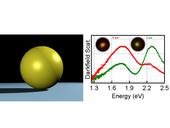Highlight
Substrates matter: influence of an adjacent dielectric on an individual plasmonic nanoparticle
Achievement/Results
Metallic nanoparticles form a broad family of nanostructures of increasing variety, complexity, and technological importance. Plasmonic nanoparticles exhibit a remarkable sensitivity to their environment, where interactions with proximal structures and materials typically influence their plasmon properties in dramatic and easily observable ways. The influence of a directly adjacent or an isotropically surrounding dielectric medium also alters the plasmonic properties of a nanoparticle. This effect has been of tremendous interest in the development of ultrasensitive localized surface plasmon resonant (LSPR) nanosensors capable of ultimately detecting individual molecular binding events. As a result, the study of plasmonic nanoparticles at the individual nanostructure level has become a major experimental and theoretical joint focus in our Nanophotonics IGERT, and has enabled numerous significant advances in our understanding of plasmons in nanoscale systems.
In this work, we showed how the properties of an adjacent dielectric slab substrate affect the plasmon modes of a spherical plasmonic nanoparticle, using polarization-dependent microspectroscopy measurements of individual nanoparticles deposited on the surface of dielectric substrates. By examining the spectra of individual nanoparticles on substrates of varying permittivity, we observe that the dielectric substrate can exert a significant influence on the nanoparticle spectrum. While a spherical nanoparticle in an isotropic 3D environment has three degenerate dipolar resonances, the reduced symmetry induced by the presence of the dielectric results in a splitting of these modes into two distinct resonances, corresponding to the nanoparticle dipole oscillating parallel and perpendicular to the substrate. These changes in mode properties are most clearly observable in the spectrum of a plasmonic nanoparticle on a high permittivity substrate (ZnSe). On lower permittivity substrates of more widespread use in single nanoparticle spectroscopy, such as silica glass, the mode splitting appears as an anomalous, “spoof” broadening of the plasmon mode of the nanoparticle-substrate system.
Two types of plasmonic nanoparticles were used in these studies: Au/silica nanoshells, dielectric core-metallic shell nanoparticles with tunable, geometry-dependent plasmon resonances, and Au nanospheres. Both particle types were deposited on one of three dielectric substrates: cleaned glass coverslips, uncoated optical grade sapphire windows, and uncoated ZnSe windows. All substrates were prepared with alignment marks evaporated through transmission electron microscopy (TEM) grids to allow the direct comparison of single particle optical spectra and geometry. Particles were deposited sparsely on these substrates to eliminate particle-particle interactions from influencing measurements.The dark-field microscopy geometry allows light at an oblique angle to be incident on an individual nanoparticle, where light scattered by the nanoparticle is collected in a broad cone of solid angles defined by the numerical aperture of the microscope objective. Isolated particles were located on a gridded substrate using an inverted optical microscope. Spectra were acquired by focusing the particle image on the entrance slit of a spectrometer and recording the image on a CCD detector array. Following optical characterization, the morphology of each nanoparticle studied was characterized using scanning electron microscopy. Theoretical spectra for nanoshells and colloid supported on an infinite film were calculated numerically using a commercially available FEM package (COMSOL Multiphysics).
In these studies, our experimental results show quite clearly that, at the single nanoparticle level, the plasmon resonance of an individual nanoparticle is controlled by the substrate upon which it is deposited. This affect of the substrate is to split the modes of the nanoparticle into those excited by light polarized in the plane of the substrate and those with an opposite optical polarization. Our studies also show how the shape of the nanoparticle affects its sensitivity of its properties to influence by this adjacent substrate. Much to our surprise, we observed a trend in this geometric dependence that revealed that solid Au nanospheres have resonances that are very strongly influenced by the substrate properties, far more than Au nanoshells, other nanoparticles that would be expected to be more sensitive to substrate properties. When Au nanospheres are placed on a substrate and studied with polarized light, a dramatic splitting between the plasmon modes is observed, resulting in a visible color change in the nanoparticle: one polarization appears red, the other appears green (see Figure). This result was unexpected, and its substantiation depended on our joint ability to accurately measure and to precisely model the “nanoparticle plus dielectric substrate” system.
Address Goals
In our IGERT we are extending the field of optics to nanoscale dimensions, designing and building nanoparticles and nanostructures to serve as unique, new optical components. This revolutionary new approach to optics is multidisciplinary in nature and requires us to think in new ways, and to develop expertise in new areas of overlapping disciplines. The close integration of theoretical modeling and experimental implementation brings chemistry and electromagnetism into a new and synergistic relationship, for example. This is a mindset that also bridges basic science with applications. The study performed here of the optical properties of individual nanoparticles and how their properties change under the influence of the substrate on which they sit, has direct relevance to the design of ultrasensitive chemical sensors that can potentially detect individual molecular binding events. The new properties revealed in the projects within our multidisciplinary IGERT will directly advance new instrumentation technologies and our scientific and technological infrastructure. It is also developing the expertise within our students to work in this highly productive new research frontier.






